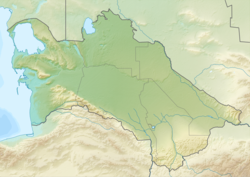Top Qs
Timeline
Chat
Perspective
Kutlug Timur Minaret
Minaret in Konye-Urgench in north Turkmenistan From Wikipedia, the free encyclopedia
Remove ads
Kutlug Timur Minaret
Summarize
Perspective
History of Minarets
A minaret is a tall slender tower, typically part of a mosque which provides a high, visible platform to call Muslims to prayer. All over the world high-rise structures are known as symbols of the power of human thought, technical capabilities, and majesty of wise rulers who were the patrons of art. [2] In the Muslim East, minarets are landmarks in many cities, and their origin is related to a belief in a relation to the gods and light symbolizing aspirations of enlightenment. Building tall minaret-like structures has been practiced by many cultures, including in Central Asia, where the Kutlug Timur Minaret was built.
History of Ancient Architecture
In the rich heritage of architecture in ancient Uzbekistan, minaret towers were created to serve both aesthetic and functional purposes. The external appearance of these towers can be divided into prism, spiral, cylindrical, and cone types, depending on the architectural forms influence of the local socioeconomic conditions.[3] These monuments demonstrate the evolution of methods of treatment of the inner surface of domes from cellular sails to stalactite, those times called "muqarnas" and brought to the highest perfection by local masters.[7]
Kutlug Timur minaret
Kunya-Urgench contains a series of monuments including a mosque, the gate of a caravanserai, fortresses, mausoleums, and a 60-meter high minaret.[7] The minaret was named after the governor of Khoresm for the Golden Horde Khanate, Qutlugh Timur, and is located on the northwest side of the Tekesh mausoleum in Kunya-Urgench, Uzbekistan.[6] Based on archarological evidence and material dating, Russian historians hypothesize that the construction of the minaret had started as early as the eleventh century under governor Abu-Abbas Mamun (1009-1017) and completed between 1321-1330 by Qutlug Timur.[6] In 2005, the ruins of Old Urgench, where the minaret is situated, were inscribed on the UNESCO List of World Heritage Sites.[4]
The Kutlug Timur Minaret is part of a group of approximately 60 minarets and towers constructed between the 11th and 13th centuries across Central Asia, Iran, and Afghanistan. Notable among these is the Minaret of Jam in Afghanistan.
Details & Decorations
When constructed the minaret stood at 65 meters tall, however, due to structural damage overtime such as earthquakes and restorative efforts it has shrunk to 60 meters. The base has a diameter of twelve meters that tapers to three meters at the top.[6] Kutlug Timur was constructed using mud brick, which is artigulated in eighteen decorative bands separated by single courses of vertical bricks. Of the eighteen decorative inscripted bands there are only three which survived. On the lowest band contains the attribution of the minaret to Qutlugh Timur, while the upper two bands are carved with Qur'anic inscriptions and verses.[6]
Remove ads
Gallery
- kutlug-Timur-Minaret with Konye Urgentch ruins in September 2011.
See also
References
Wikiwand - on
Seamless Wikipedia browsing. On steroids.
Remove ads





